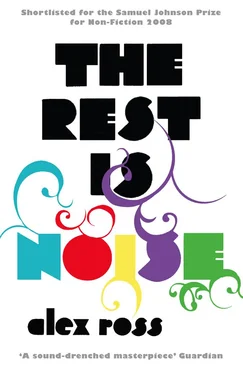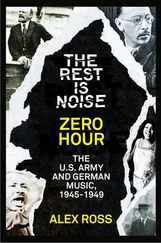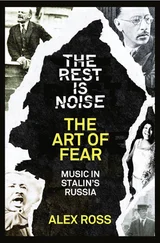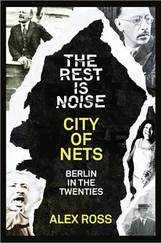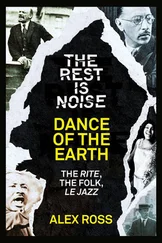In Italy, where the Futurists were promoting an art of speed, struggle, aggression, and destruction, Luigi Russolo issued a manifesto for a “MUSIC OF NOISE” and began to construct noise-instruments with which to produce the roaring, whistling, whispering, screeching, banging, and groaning sounds that he had predicted in his pamphlet. In the United States, Charles Ives, a young New England composer under the influence of Transcendentalism, began writing music in several keys at once or none at all. And Busoni, in his Sketch of a New Aesthetic of Music of 1907, theorized all manner of extra-tonal experiments, and realized a few of them in his own works.
The teleological historian might describe all this activity as the collective movement of a vanguard, one that was bent on sweeping aside the established order. Yet each of these composers was following his or her own course (to take Scriabin’s projected gender ambiguity into account), and in each case the destination was unique. Out of all of them, only Schoenberg really adopted atonality. What set him apart was that he not only introduced new chords but eliminated, for the time being, the old ones. “You are proposing a new value in place of an earlier one, instead of adding the new one to the old,” Busoni observed in a letter of 1909.
Wagner, Strauss, and Mahler all counterbalanced their novel sonorities with massive statements of common chords; dissonance and consonance existed in mutually reinforcing tension. Debussy, likewise, populated his foggy harmonic terrain with quaint melodic characters. Scriabin maintained a feeling of tonal centricity even in the most harmonically far-out stretches of his later piano sonatas. Schoenberg was the one who insisted that there was no going back. Indeed, he began to say tonality was dead—or, as Webern later put it, “We broke its neck.”
The first report of the death of tonality came in the pages of Harmonielehre, or Theory of Harmony, which Schoenberg published in 1911, with a dedication to the “hallowed memory of Gustav Mahler.” From the start the author makes clear his detestation of the prevailing musical, cultural, and social order. “Our age seeks many things,” he writes in the preface. “What it has found, however, is above all: comfort … The thinker, who keeps on searching, does the opposite. He shows that there are problems and that they are unsolved. As does Strindberg: ‘Life makes everything ugly.’ Or Maeterlinck: ‘Three quarters of our brothers [are] condemned to misery.’ Or Weininger and all others who have thought earnestly.” A musical morality is introduced: the easy charm of the familiar on the one side, the hard truth of the new on the other.
Harmonielehre turns out to be an autopsy of a system that has ceased to function. In the time of the Viennese masters, Schoenberg says, tonality had had a logical and ethical basis. But by the beginning of the twentieth century it had become diffuse, unsystematic, incoherent—in a word, diseased. To dramatize this supposed decline, the composer augments his discourse with the vocabulary of social Darwinism and racial theory. It was then fashionable to believe that certain societies and races had corrupted themselves by mixing with others. Wagner, in his later writings, made the argument explicitly racial and sexual, saying that the Aryan race was destroying itself by crossbreeding with Jews and other foreign bodies. Weininger made the same claim in Sex and Character.
Schoenberg applied the concept of degeneration to music. He introduced a theme that would reappear often as the century went on—the idea that some musical languages were healthy while others were degenerate, that true composers required a pure place in a polluted world, that only by assuming a militant asceticism could they withstand the almost sexual allure of dubious chords.
In the nineteenth century, Schoenberg says, tonality had fallen prey to “inbreeding and incest.” Transitional or “vagrant” chords such as the diminished seventh—a harmonically ambiguous four-note entity that can resolve in several different directions—were the sick offspring of incestuous relationships. They were “sentimental,” “philistine,” “cosmopolitan,” “effeminate,” “hermaphroditic”; they had grown up to be “spies,” “turncoats,” “agitators.” Catastrophe was inevitable. “[T]he end of the system is brought about with such inescapable cruelty by its own functions … [T]he juices that serve life, serve also death.” And: “Every living thing has within it that which changes, develops, and destroys it. Life and death are both equally present in the embryo.” Weininger wrote in similar terms in Sex and Character: “All that is born of woman must die. Reproduction, birth, and death are inextricably linked … The act of coitus, considered not only psychologically but also ethically and biologically, is akin to murder.” Moreover, Schoenberg’s description of those rootless chords—“homeless phenomena, unbelievably adaptable … They flourish in every climate”—actually resembles Weininger’s description of the effeminate, cosmopolitan Jew, who “adapts himself … to every circumstance and every race; like the parasite, he becomes another in every host, and takes on such an entirely different appearance that one believes him to be a new creature, although he always remains the same. He assimilates himself to everything.”
The weird undercurrent of racial pseudoscience in Harmonielehre raises the question of Schoenberg’s Jewish identity. He was born in Leopoldstadt, a section of Vienna that was heavily populated by former members of the eastern shtetl communities, many of whom had fled the pogroms. Like cultivated Austrian Jews such as Mahler, Kraus, and Wittgenstein, Schoenberg might have felt the need to distance himself from the stereo type of the ghetto Jew; perhaps this explains his conversion to Lutheranism in 1898, which, unlike Mahler’s conversion to Catholicism the previous year, was not motivated by the offer of an official post. Later, as anti-Semitism became ever more unavoidable in Austro-German life, Schoenberg’s sense of his identity underwent a dramatic change. By 1933, when he went into exile, he had returned to his faith, and remained intensely if eccentrically devoted to it thereafter.
In a way, Schoenberg’s journey resembles that of Theodor Herzl, the progenitor of political Zionism, whose early attacks on self-satisfied assimilated urban Jews could be mistaken for anti-Semitic diatribes. The scholar Alexander Ringer has argued that Schoenberg’s atonality may have been an oblique affirmation of his Jewishness. In this reading, it is a kind of musical Zion, a promised land in whose dusty desert climate the Jewish composer could escape the ill-concealed hatred of bourgeois Europe.
Schoenberg would prove uncannily alert to the murderousness of Nazi anti-Semitism. In 1934, he predicted that Hitler was planning “no more and no less than the extermination of all Jews!” Such thoughts were presumably not on his mind circa 1907 and 1908, yet to be Jewish in Vienna was to live under a vague but growing threat. Anti-Semitism was shifting from a religious to a racial basis, meaning that a conversion to Catholicism or Protestantism no longer sufficed to solve one’s Jewish problem. Rights and freedoms were being picked off one by one. Jews were expelled from student societies, boycotts instituted. There were beatings in the streets. Rabble-rousers spouted messages of hate. Hitler himself was somewhere in the background, trying to make his way as an artist, building a cathedral of resentment in his mind. As the historian Steven Beller writes, Jews were “at the center of culture but the edge of society.” Mahler ruled musical Vienna; at the same time, Jewish men never felt safe walking the streets at night.
Читать дальше
